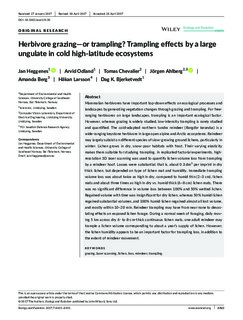| dc.description.abstract | Mammalian herbivores have important top-down effects on ecological processes and landscapes by generating vegetation changes through grazing and trampling. For free-ranging herbivores on large landscapes, trampling is an important ecological factor. However, whereas grazing is widely studied, low-intensity trampling is rarely studied and quantified. The cold-adapted northern tundra reindeer (Rangifer tarandus) is a wide-ranging keystone herbivore in large open alpine and Arctic ecosystems. Reindeer may largely subsist on different species of slow-growing ground lichens, particularly in winter. Lichen grows in dry, snow-poor habitats with frost. Their varying elasticity makes them suitable for studying trampling. In replicated factorial experiments, high-resolution 3D laser scanning was used to quantify lichen volume loss from trampling by a reindeer hoof. Losses were substantial, that is, about 0.3 dm3 per imprint in dry thick lichen, but depended on type of lichen mat and humidity. Immediate trampling volume loss was about twice as high in dry, compared to humid thin (2–3 cm), lichen mats and about three times as high in dry vs. humid thick (6–8 cm) lichen mats, There was no significant difference in volume loss between 100% and 50% wetted lichen. Regained volume with time was insignificant for dry lichen, whereas 50% humid lichen regained substantial volumes, and 100% humid lichen regained almost all lost volume, and mostly within 10–20 min. Reindeer trampling may have from near none to devastating effects on exposed lichen forage. During a normal week of foraging, daily moving 5 km across dry 6- to 8-cm-thick continuous lichen mats, one adult reindeer may trample a lichen volume corresponding to about a year's supply of lichen. However, the lichen humidity appears to be an important factor for trampling loss, in addition to the extent of reindeer movement. | nb_NO |

